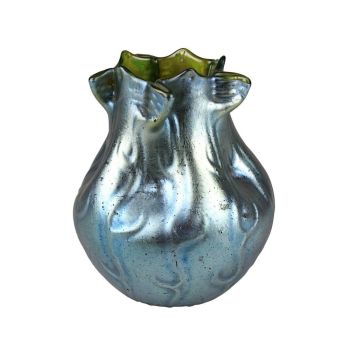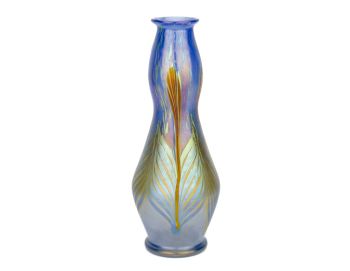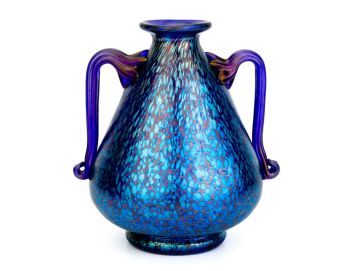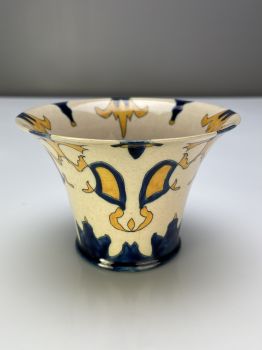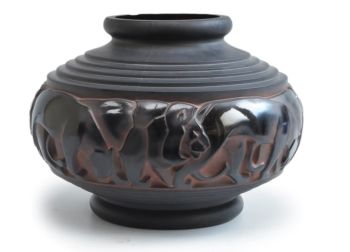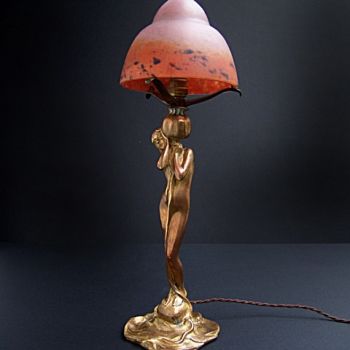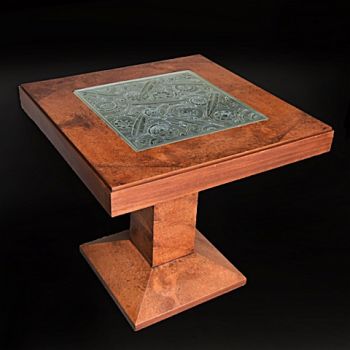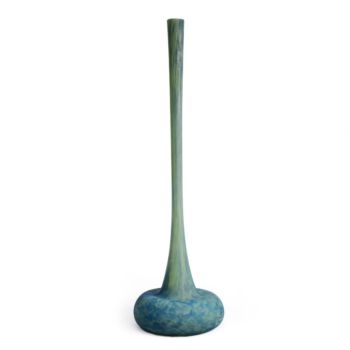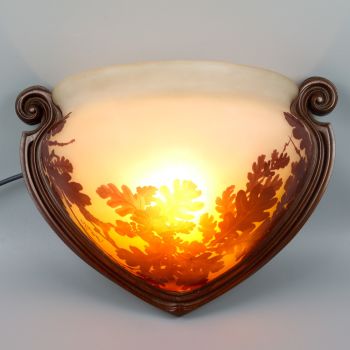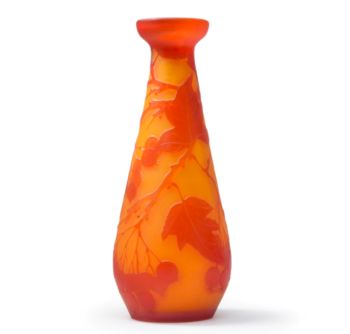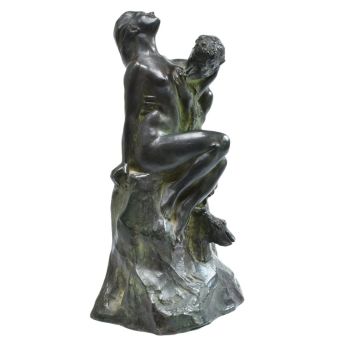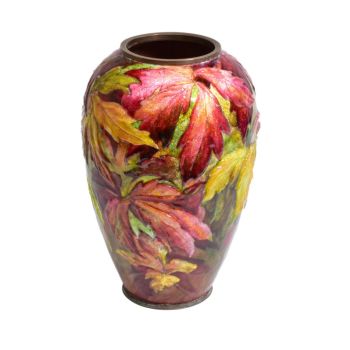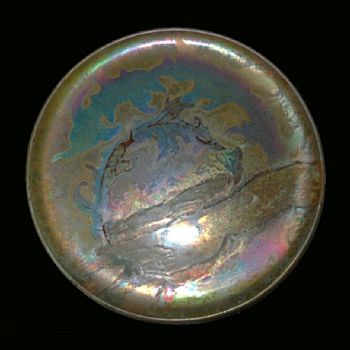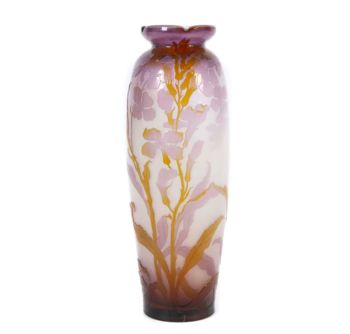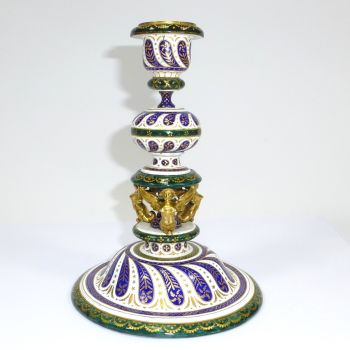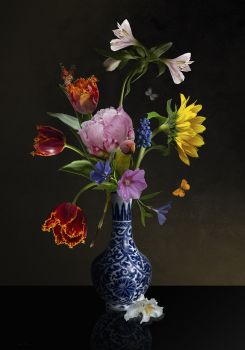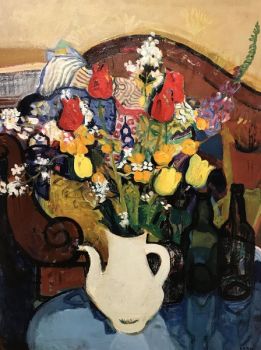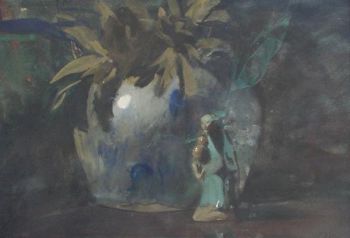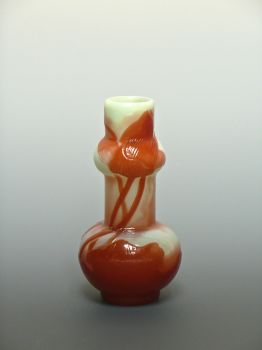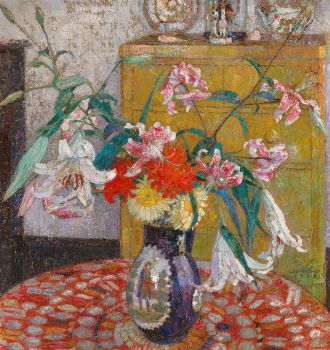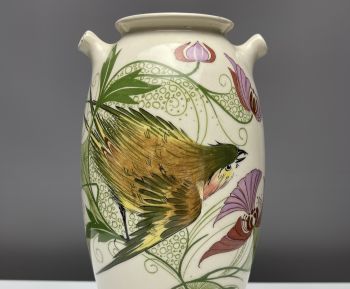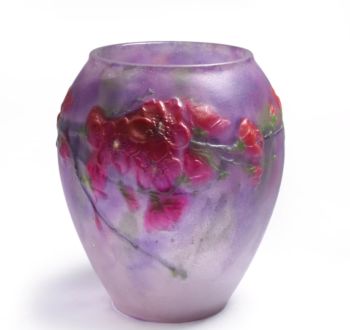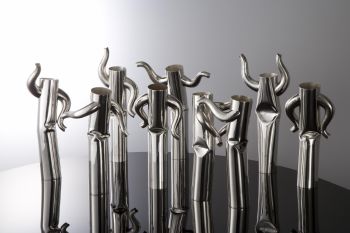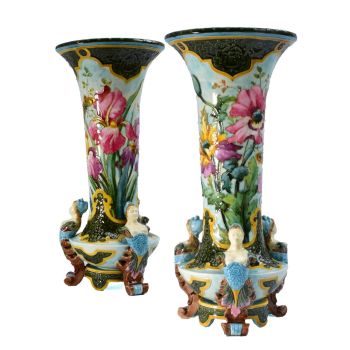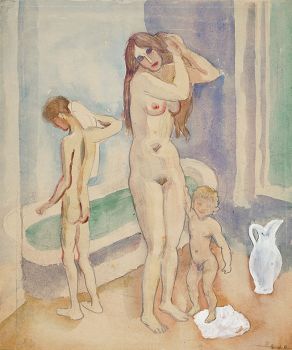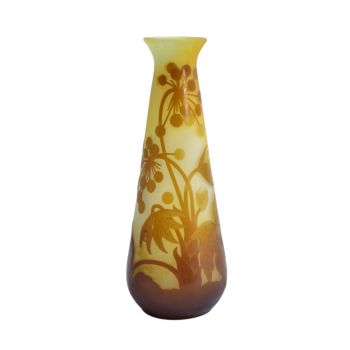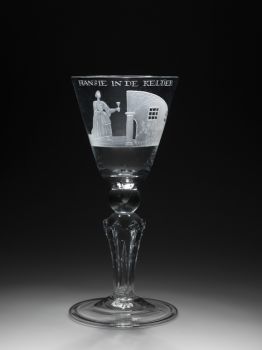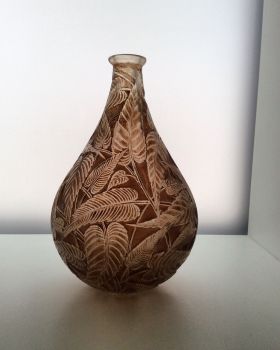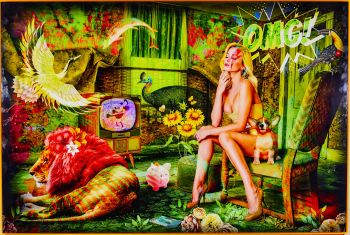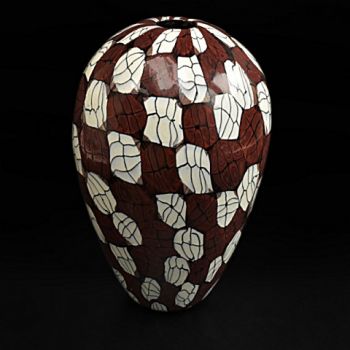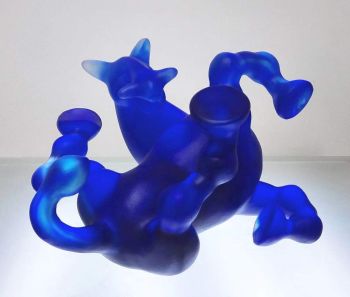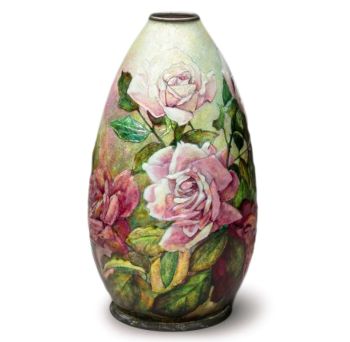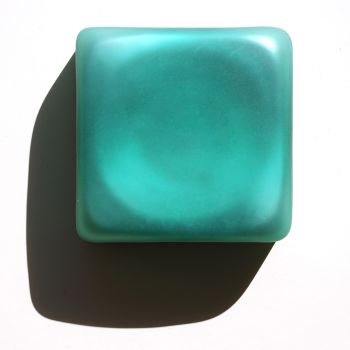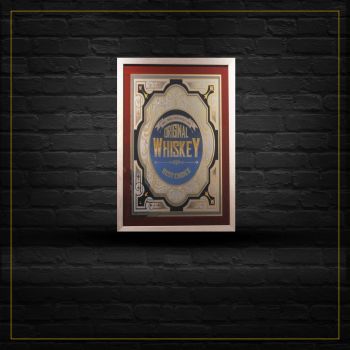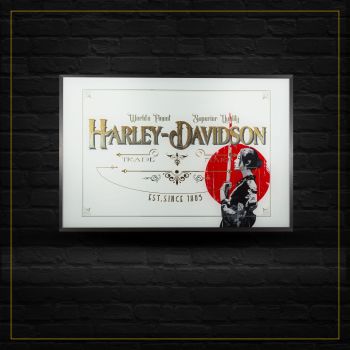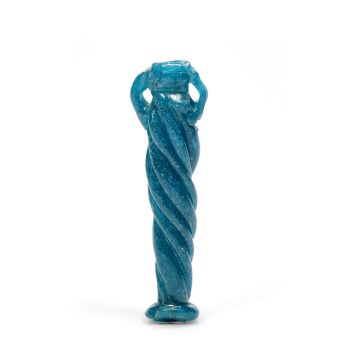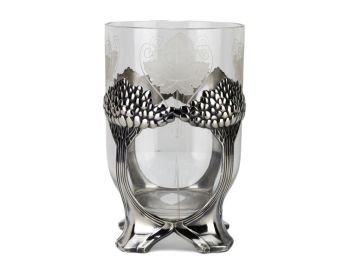Johann Loetz Witwe – “Zebra” decor, designed by Koloman Moser for E. Bakalowits – 1903 1903
Johann Loetz (Lötz) Witwe Klostermühle
Glass
8 cm, ø 7 cm
ConditionMint
Price on request
Antiques Emporium
- About the artworkIntroducing a rare and captivating piece by Johann Loetz Witwe, featuring the exceptionally rare Zebra decor, designed by the renowned Koloman Moser in 1903 for E. Bakalowits, Vienna. This exquisite vase/cup is a true testament to the artistic brilliance and innovative craftsmanship of the early 20th century.
The Zebra decor is a distinctive and highly sought-after pattern, characterized by its striking black and white or contrasting dark and light bands that mimic the natural beauty of zebra stripes. The intricate glasswork and iridescent finish highlight the exceptional skill and artistry of Loetz glassmakers.
Koloman Moser, a pivotal figure in the Vienna Secession movement, designed the Zebra decor in 1903. Moser was instrumental in shaping modern design, blending artistic creativity with functional elegance. His work in 1903 was marked by groundbreaking designs that pushed the boundaries of traditional decorative arts.
This vase/cup is not just a decorative item but a piece of history. In 1903, Moser’s designs were revolutionizing interiors, moving towards modern, geometric styles that emphasized simplicity and elegance. His collaboration with Loetz and E. Bakalowits resulted in pieces that were both artistic and commercially successful, appealing to the discerning tastes of the time.
Koloman Moser (1868-1918) was one of the foremost designers of the Vienna Secession, a movement that sought to break away from the historical emphasis on traditional styles. In 1903, Moser was at the height of his career, creating innovative designs that were both functional and aesthetically pleasing. His work during this period included not only glassware but also furniture, textiles, and entire interior designs, showcasing his versatile talent and visionary approach.
This vase/cup, with its Zebra decor, is an excellent addition to any modern interior. Its bold pattern and elegant form make it a striking centerpiece, whether displayed on its own or as part of a collection. The piece reflects the transition towards modern design principles that Moser championed, making it both a timeless and contemporary artifact.
Dimensions:
Height: 88mm / 3.46”
Diameter top: 75mm / 2.95”
Diameter base: 65mm / 2.56″
Condition: Mint
Literature:
Hatje Cantz – Loetz Bohemian Glass 1880 – 1940 – Page 159, 160 & 316.
Prestel – Böhmisch Glas 1880 – 1940 Band 1 Werkmonographie – Page 172, 173, 178 & 340 . - About the artist
Lötz/Loetz was founded by Johann Lötz in 1840 and was a company based in Bohemia, in the Czech Republic, at the time Lötz belonged to the Empire of Austria-Hungary. In 1879, a grandson of Lötz, Max Ritter-Von Spaun, took over the business from his grandmother and kept the name Joh. Lötz Witwe.
From that moment on, Johann Lötz Witwe really started to make a name for itself, they developed new innovative glass techniques, but their design and bright colors were also completely innovative. They designed special shapes and vases, luxury items, which they sold in luxury shops in Vienna, Berlin, Hamburg, Paris, London, Milan, Brussels and Madrid. It soon made them very well known and famous.
It was the period that Art Nouveau or as it was called in Germany Jugendstil flourished. They used organic shapes, nature was their example, also for Lötz, they developed beautiful decors, resembling butterfly wings, such as the papillon decor of this vase, often the shapes were formed organically by using tongs to shape the hot glass unevenly , as also flowers are formed. But also an octopus or sea shells were taken as examples for their special vases and decors.
Lötz participated in all kinds of World Exhibitions, including the famous World Exhibition of 1900 in Paris where they won the Grand Prize. They were awarded numerous prizes for participation in World Exhibitions. Max Ritter von Spaun also received special awards for his contribution to the glass industry, in 1883 he was allowed to use the Imperial eagle in their shield and seal, they were also allowed to use K.K. Put Private Glass Factory in front of their name. In 1889 he also received a knighthood from Franz Josef. But other royal houses were also involved. He received the Belgian Order of Leopold and the honorable French Legion d'Honneur.
Their designs were popular, also in the United States. Tiffany worked with Lötz on the Favril set. Lötz patented some of their special techniques, such as the one they used to make the Phänomen decor. They were able to make iridescent glass. In short, Lötz had become a household name. And it still is.
Lötz also worked closely with other glass manufacturers such as J.&L. Lobmeyer and E. Bakolowits Söhne in Vienna and with Argentor. In addition, Lötz worked closely with various artists, such as Josef Hoffmann, Koloman Moser, Franz Hofstötter, Michael Powolny and other artists from the Wiener Werkstätte. Michael Powolny was responsible for the much tighter tango vases of the 1920s.
The First World War and the end of the Austrian Empire meant a difficult period for Lötz.
Lötz existed until 1940, after a bombing raid the factory was completely burnt down. After WWII, the Czech Republic belonged to the satellite states of the Soviet Union, the factory was nationalized until it was finally closed in 1947.Lötz glass is still very popular and is collected worldwide, in addition, their oeuvre can also be found in many museum collections.
Are you interested in buying this artwork?
Artwork details
Related artworks
Johann Loetz (Lötz) Witwe Klostermühle
Johann Loetz Witwe - Phänomen Genre 7773 – Orange1900 - 1910
Price on requestAntiques Emporium
Johann Loetz (Lötz) Witwe Klostermühle
Johann Loetz Witwe – Jugendstil Cobalt Papillon vaas1900 - 1910
Price on requestAntiques Emporium
1 - 4 / 7- 1 - 4 / 24
Frères Daum
Daum Nancy – “Paysage Soleil Couchant” vase with two applied handles1900 - 1910
Price on requestAntiques Emporium
Amalric Walter
Amalric Walter & Henri Bergé – Crabe plumier1920 - 1929
Price on requestAntiques Emporium
Gabriel Argy-Rousseau
Gabriël Argy-Rousseau – Crabes et Algues vase – 19201920 - 1929
Price on requestAntiques Emporium
1 - 4 / 24Johann Loetz (Lötz) Witwe Klostermühle
Johann Loetz Witwe - Phänomen Genre 7773 – Orange1900 - 1910
Price on requestAntiques Emporium
Jan Voerman sr
Still Life with flowers in a Chinese figurine1850 - 1900
Price on requestKunsthandel Pygmalion
Herman Bogman jr.
Flower still life of a nasturtium in a blue vase1950 - 1965
Price on requestAdelwein Kunst
1 - 4 / 24Frères Daum
Daum Nancy – “Paysage Soleil Couchant” vase with two applied handles1900 - 1910
Price on requestAntiques Emporium
1 - 4 / 24Johann Loetz (Lötz) Witwe Klostermühle
Johann Loetz Witwe – Jugendstil Cobalt Papillon vaas1900 - 1910
Price on requestAntiques Emporium
Frères Daum
Daum Nancy – “Paysage Soleil Couchant” vase with two applied handles1900 - 1910
Price on requestAntiques Emporium
Amalric Walter
Amalric Walter & Henri Bergé – Crabe plumier1920 - 1929
Price on requestAntiques Emporium
Unknown artist
François-Théodore Legras – Tall “Fleurs de Pommier” apple blossoms vase1900 - 1909
Price on requestAntiques Emporium
1 - 4 / 12












